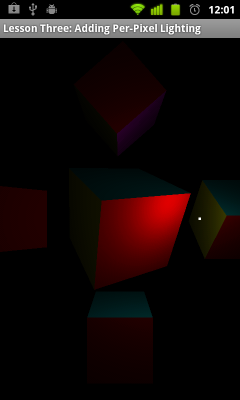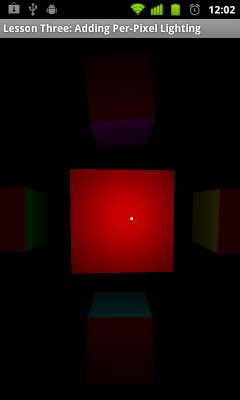
Welcome to the the third tutorial for Android! In this lesson, we’re going to take everything we learned in lesson two and learn how to apply the same lighting technique on a per-pixel basis. We will be able to see the difference, even when using standard diffuse lighting with simple cubes.
Assumptions and prerequisites
Each lesson in this series builds on the lesson before it. This lesson is an extension of lesson two, so please be sure to review that lesson before continuing on. Here are the previous lessons in the series:
What is per-pixel lighting?
Per-pixel lighting is a relatively new phenomenon in gaming with the advent of the use of shaders. Many famous old games such as the original Half Life were developed before the time of shaders and featured mainly static lighting, with some tricks for simulating dynamic lighting using either per-vertex (otherwise known as Gouraud shading) lights or other techniques, such as dynamic lightmaps.
Lightmaps can give a very nice result and can sometimes give even better results than shaders alone as expensive light calculations can be precomputed, but the downside is that they take up a lot of memory and doing dynamic lighting with them is limited to simple calculations.
With shaders, a lot of these calculations can now be offloaded to the GPU, which allows for many more effects to be done in real-time.
Moving from per-vertex to per-fragment lighting
In this lesson, we’re going to look at the same lighting code for a per-vertex solution and a per-fragment solution. Although I have referred to this type of lighting as per-pixel, in OpenGL ES we actually work with fragments, and several fragments can contribute to the final value of a pixel.
Mobile GPUs are getting faster and faster, but performance is still a concern. For “soft” lighting such as terrain, per-vertex lighting may be good enough. Ensure you have a proper balance between quality and speed.
A significant difference between the two types of lighting can be seen in certain situations. Take a look at the following screen captures:
|
|
|
In the per-vertex lighting in the left image, the front face of the cube appears as if flat-shaded, and there is no evidence of a light nearby. This is because each of the four points of the front face are more or less equidistant from the light, and the low light intensity at each of these four points is simply interpolated across the two triangles that make up the front face. The per-fragment version shows a nice highlight in comparison. |
|
The left image shows a Gouraud-shaded cube.As the light source moves near the corner of the front face of the cube, a triangle-like effect can be seen. This is because the front face is actually composed of two triangles, and as the values are interpolated in different directions across each triangle we can see the underlying geometry. The per-fragment version shows no such interpolation errors and shows a nice circular highlight near the edge. |
An overview of per-vertex lighting
Let’s take a look at our shaders from lesson two; a more detailed explanation on what the shaders do can be found in that lesson.
Vertex shader
uniform mat4 u_MVPMatrix; // A constant representing the combined model/view/projection matrix.
uniform mat4 u_MVMatrix; // A constant representing the combined model/view matrix.
uniform vec3 u_LightPos; // The position of the light in eye space.
attribute vec4 a_Position; // Per-vertex position information we will pass in.
attribute vec4 a_Color; // Per-vertex color information we will pass in.
attribute vec3 a_Normal; // Per-vertex normal information we will pass in.
varying vec4 v_Color; // This will be passed into the fragment shader.
// The entry point for our vertex shader.
void main()
{
// Transform the vertex into eye space.
vec3 modelViewVertex = vec3(u_MVMatrix * a_Position);
// Transform the normal's orientation into eye space.
vec3 modelViewNormal = vec3(u_MVMatrix * vec4(a_Normal, 0.0));
// Will be used for attenuation.
float distance = length(u_LightPos - modelViewVertex);
// Get a lighting direction vector from the light to the vertex.
vec3 lightVector = normalize(u_LightPos - modelViewVertex);
// Calculate the dot product of the light vector and vertex normal. If the normal and light vector are
// pointing in the same direction then it will get max illumination.
float diffuse = max(dot(modelViewNormal, lightVector), 0.1);
// Attenuate the light based on distance.
diffuse = diffuse * (1.0 / (1.0 + (0.25 * distance * distance)));
// Multiply the color by the illumination level. It will be interpolated across the triangle.
v_Color = a_Color * diffuse;
// gl_Position is a special variable used to store the final position.
// Multiply the vertex by the matrix to get the final point in normalized screen coordinates.
gl_Position = u_MVPMatrix * a_Position;
}
Fragment shader
precision mediump float; // Set the default precision to medium. We don't need as high of a
// precision in the fragment shader.
varying vec4 v_Color; // This is the color from the vertex shader interpolated across the
// triangle per fragment.
// The entry point for our fragment shader.
void main()
{
gl_FragColor = v_Color; // Pass the color directly through the pipeline.
}
As you can see, most of the work is being done in our vertex shader. Moving to per-fragment lighting means that our fragment shader is going to have more work to do.
Implementing per-fragment lighting
Here is what the code looks like after moving to per-fragment lighting.
Vertex shader
uniform mat4 u_MVPMatrix; // A constant representing the combined model/view/projection matrix.
uniform mat4 u_MVMatrix; // A constant representing the combined model/view matrix.
attribute vec4 a_Position; // Per-vertex position information we will pass in.
attribute vec4 a_Color; // Per-vertex color information we will pass in.
attribute vec3 a_Normal; // Per-vertex normal information we will pass in.
varying vec3 v_Position; // This will be passed into the fragment shader.
varying vec4 v_Color; // This will be passed into the fragment shader.
varying vec3 v_Normal; // This will be passed into the fragment shader.
// The entry point for our vertex shader.
void main()
{
// Transform the vertex into eye space.
v_Position = vec3(u_MVMatrix * a_Position);
// Pass through the color.
v_Color = a_Color;
// Transform the normal's orientation into eye space.
v_Normal = vec3(u_MVMatrix * vec4(a_Normal, 0.0));
// gl_Position is a special variable used to store the final position.
// Multiply the vertex by the matrix to get the final point in normalized screen coordinates.
gl_Position = u_MVPMatrix * a_Position;
}
The vertex shader is simpler than before. We have added two linearly-interpolated variables to be passed through to the fragment shader: the vertex position and the vertex normal. Both of these will be used when calculating lighting in the fragment shader.
Fragment shader
precision mediump float; // Set the default precision to medium. We don't need as high of a
// precision in the fragment shader.
uniform vec3 u_LightPos; // The position of the light in eye space.
varying vec3 v_Position; // Interpolated position for this fragment.
varying vec4 v_Color; // This is the color from the vertex shader interpolated across the
// triangle per fragment.
varying vec3 v_Normal; // Interpolated normal for this fragment.
// The entry point for our fragment shader.
void main()
{
// Will be used for attenuation.
float distance = length(u_LightPos - v_Position);
// Get a lighting direction vector from the light to the vertex.
vec3 lightVector = normalize(u_LightPos - v_Position);
// Calculate the dot product of the light vector and vertex normal. If the normal and light vector are
// pointing in the same direction then it will get max illumination.
float diffuse = max(dot(v_Normal, lightVector), 0.1);
// Add attenuation.
diffuse = diffuse * (1.0 / (1.0 + (0.25 * distance * distance)));
// Multiply the color by the diffuse illumination level to get final output color.
gl_FragColor = v_Color * diffuse;
}
With per-fragment lighting, our fragment shader has a lot more work to do. We have basically moved the Lambertian calculation and attenuation to the per-pixel level, which gives us more realistic lighting without needing to add more vertices.
Further exercises
Could we calculate the distance in the vertex shader instead and simply pass that on to the pixel shader using linear interpolation via a varying?
Wrapping up
The full source code for this lesson can be downloaded from the project site on GitHub.
As always, please don’t hesitate to leave feedbacks or comments, and thanks for stopping by!



